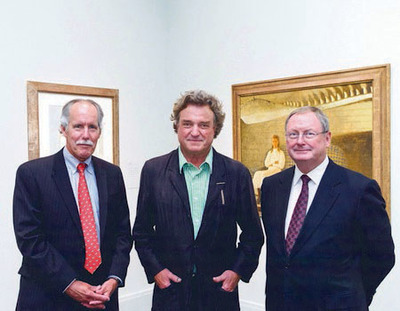Within the Hay, Jamie Wyeth
What do Arnold Schwarzenegger, Andy Warhol and a bale of hay have in common? No, that’s not the set up to some immodest cocktail party punch line. The answer is far more interesting than that. It turns out they have all been, at one time or another, among the many strange obsessions of Jamie Wyeth. That’s how he describes the subjects of more than 100 paintings on view now (a mere fraction of his 3,000 compositions and counting) at the Museum of Fine Arts, Boston.
Having an exhibition of this scale, Wyeth jokes, is “very painful,” and he’s assuredly “not just being cute” about it. This major retrospective is his first, spanning the length of his career from age three—when he was already competitively drawing over his esteemed father Andrew Wyeth’s pictures—to his works of just last fall. It is, for Jamie Wyeth, five galleries worth of the “various worlds I’ve entered through paintings” over the years. For museumgoers, the retrospective offers the uncanny experience of revisiting the artist’s creative process as it was taking shape. As Wyeth told the crowd at his opening reception, he is often asked if these paintings of the past six decades aren’t almost like children to him. “Yeah, like children,” he laughs, “get rid of them!” His works are past obsessions—and they are enduring ones.
The Brandywine tradition of painting is the vein of American realism in which Wyeth, like his father Andrew and grandfather N.C. before him, is most often counted. Yet there is more to his representational paintings than meets the eye, contemporary art criticism aside. There are terrifying moods and disturbing undercurrents in Wyeth’s work, a kind of surreal landscape of the mind within his “combined mediums,” as he puts it. Wyeth’s 2005 series The Seven Deadly Sins harkens back to his 20 by 40 foot-wide 1969 painting Original Sin (inspired by carnies), which he painted on the floor of his barn in Maine. Seagulls are his subjects in this more recent series but they are hardly hotel material. “Do you ever watch seagulls?” Wyeth asks. “They’re very mean, very nasty, scavengers, cannibalistic…and that’s the quality I love about them.” His interest in the unsettling is longstanding. “Just to show you how strange these paintings are,” he remarks, “one is owned by Stephen King.”

l. to r. Bob Gallery, Jamie Wyeth and Malcolm Rogers at Wyeth’s exhibition at the MFA, Boston. Photograph © Museum of Fine Arts, Boston.
Whatever has possessed Jamie Wyeth over the years, whether it’s people, places, bales of hay or pumpkins, is bound to turn up in his retrospective. Wyeth spent a year painting Rudolf Nureyev in the late 1970s, through whom he met Andy Warhol, “a Halloween-type figure in looks” who had a fondness for Wyeth’s “cuteness.” At the tender age of 20, Wyeth was approached by the Kennedy family to paint an official portrait of the late John F. Kennedy, a recent acquisition by the MFA (and a fixture above Vice President Joe Biden’s fireplace for a time). Controversial during its day, the 1967 portrait, a product of two years of immersive observation, is now a national stamp of Ireland.
Larger-than-life ravens (“why not paint them human-size?” after all) and angry rams are on view alongside landscapes and portraits of his beloved wife, Phyllis. Bale, 1972 is, in Wyeth’s estimation, “a portrait as much as the portrait of JFK.” He had become “obsessed with that bale of hay,” too. When a neighborly farmer asked upon seeing the painting, “When did you get the John Deere baler?” Wyeth considered it the highest compliment.
These days, Wyeth paints on Maine’s Monhegan Island, a place frequented by his father and grandfather. Its scenery beckons painters far and wide. “Everywhere you look in Monhegan, there’s a painter,” he quips unhappily. But Jamie Wyeth is not drawn to the picturesque like the others. His imaginary portrait of painter Rockwell Kent, whose Monhegan home he bought in 1968, transports viewers to the “dark side of the island.” In the distance, Kent’s former model Sally Moran can be seen falling from a cliff into the sea. Kent had been accused of murdering Moran in the summer of 1953. “The investigation was reopened because of this painting,” Wyeth remarks, imaginary though it may be, having been painted 42 years after Kent’s death in 1971.
That is what is so seductive about Wyeth’s work. It combines the realism of the world as it is with the unconscious realm of the mind and its darker impulses, tapping into the surreal in the everyday and the undercurrents of the imagination. “Maine,” Wyeth reminds us, “has produced more bad painting than any other state.” Fortunately, it has also given us the works of Jamie Wyeth.
Robyn Day is a photographer who has shown her work nationally. She writes about the arts for Art New England, Aint-Bad Magazine and Big Red & Shiny.
Jamie Wyeth
On view through December 28, 2014
Museum of Fine Arts, Boston
mfa.org
